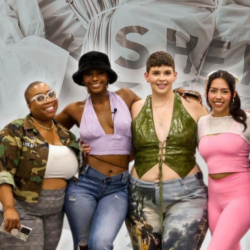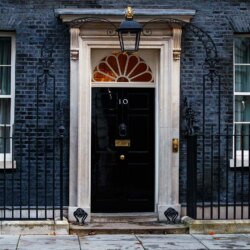In the past three months, I have chuckled and belly laughed at…
The slapstick viral video of the poor woman who gets her coat caught in shop shutters and gets lifted up. The ‘oh no’ moment when the BBC newsreader was caught sticking her fingers up live on air. The new Shreddies (WTF?!) breakfast affirmations commercial. An ongoing eight-year slow recall chuckle to the ridiculousness of the Boaty Mc Boat Face story. My four-year-old son’s persistent use of ‘vomick’ to mean vomit.
All evidence of the infinite diversity of format, theme, execution and timing of humour. It is, indeed, a powerful and richly diverse landscape. We know that whilst humour in marketing and advertising is, too, incredibly diverse, it is also incredibly powerful:
It drives brand preference: 91% of people globally prefer brands to be funny.
Drives differentiation: Over half the winners (52%) of Cannes Film Lions in 2023 were intentionally funny. ‘This could translate into creative effectiveness winners in 2024 as humour is more memorable, distinctive and persuasive as well as encouraging recommendation.’
Creates earned media value and fame: According to research, 80% of people are likely to recommend a brand to friends and family if it uses humour.
Drives memorability: The Happiness Report found that 90% of people are more likely to remember ads that are funny, and 72% of people would choose a humorous brand over the competition.
Creates unique brand identities and ‘funny brands’: With funny as a key attribute, take Paddy Power for example and its ongoing ‘show’.
Retains existing customers — and is a value exchange: 48% of respondents said they don’t believe they have a relationship with a brand unless it makes them smile or laugh, and 41% said they would step away from a brand if it doesn’t make them smile or laugh regularly. 80% of research respondents said they were more likely to buy from a brand again if it used humour.
But whilst we know the discourse around humour in advertising, and discussion is prolific, activation of it has sadly been in decline, to only recently see an uptick. Only 33% of the ads analysed by Kantar incorporate some form of humour, despite half of its Creative Effectiveness Award-winners using humour.
I believe a few things have been at play over the past two decades
- As an industry we grew up, professionalised and humour as an output of our work could be considered infantile, not serious and immature. Desperate to play in the real boardrooms not just our own, we became more serious as did our work. We didn’t want the output of our work to self-deprecate our profession. We even stopped bouncing on birthing balls, wearing red socks and for the most, dressing like cartoon characters.
- As budgets became ever more under scrutiny humour could have been considered being frivolous. Despite ninety-one percent of people globally prefer brands to be funny, yet 95% of business leaders fear using humour in consumer interactions, according to a report from Oracle and author-podcaster Gretchin Rubin.
- We became obsessed with ‘empathy’, and we took that to be being sensitive to the cultural forces at play and needing to be seriously empathetic to the world going to shit.
- We became obsessed with Purpose beyond the small p and often this made it hard to inject humour when you were trying to solve the worlds problems through a slab of butter.
- We worried funny could mean not worth it. In a cost-of-living crisis, we worried why would people pay more for something which didn’t take itself seriously. Not serious = risk of not being worth (enough). Being funny could mean not important and would that make our brands price inelastic.
- I am ‘seriously’ hoping the recent announcement of Cannes category for Humour — and the uptick are signs of permanent and positive things to come, and the industry recognises the power of humour. That doesn’t mean we are not professional, serious, lack empathy, or are worth it. Instead, we recognise what we have access to — an intimacy with people, through a rich and infinite number of formats, executions, strategies, and touchpoints.
I hope this is a turning point and we recognise the power of humour and its ability to…
Show smarts. Brands who use humour can demonstrate wisdom. Humour is linked with wisdom — a wise person knows how to use humour or when to laugh at oneself.
Show empathy. Brands who use humour explicitly show they get people. That they have real human insight — and intuition. In my opinion, some of the best work comes in explicit, subtle funny use of insight, for example — in IKEA’s Proudly Second-Best work (below).
Add value, quite literally. Humour can make brands add value in the work itself. Satisfied my hunger and left me sated by filling a laughter hole.
Be culturally empathetic: People have never wanted funny more. 88% of people are looking for new experiences to make them smile and laugh. We’re seeing it rise exponentially in stand-up and movies.
Apply it best across media. We also need to unlock the power of media planning. And how media strategies have the power to make funny stick. Creating a media strategy around funny is phenomenally exciting.
What about ‘full funnel’ funny?
Some channels are funnier than others and humour has its place historically in some more than others. Radio, AV and TikTok, yes, but what about full funnel humour, which is rare? With Search, CRM and Commerce we’re more serious here, at the bottom of funnel. Serious language. Serious metrics. Serious copy. Could we inject some humorous light at end of tunnel — full funnel humour? Find funny in more disruptive ways. Only 18% of brands report using the tactic in online ads. Even on social media, 75% of respondents said they would follow a brand on social media if it was funny, despite only 15% of brands using humour on social media.
Even in email titles — research also suggests humour can help improve email marketing campaign open rates, which currently hover around 21%. 69% of respondents said they would open an email from a brand if the subject line was funnier, yet only 24% of business leaders report using humour in email marketing campaigns.
Recognise the power of ‘it’s all in the timing’
There are certain times of year/week/month/day when receptivity to humour and need for it is higher. (End of week, end of day and end of month according to Touchpoints data.) Funny doesn’t always need to be paid. Recognising the power of owned, and influence funny: take Innocent’s owned social posts, or Aldi’s response to the wider cultural picture.
Funny work travels
Be aware of how sociable humour can be, and create work which travels and that people talk about. Take Shreddies new TVC, or Bud Light’s ‘wassup’ entering the vernacular. Make funny work that sticks, and travels.
This shouldn’t be the industry entering a funny fug where, like ‘purpose’, we can’t move for funny. And obviously funny shouldn’t apply to all brands, all of the time. But if we all recognise the power of funny, in all its various shades and formats, across the richness of touchpoint planning, we can use it to drive acquisition and retention, make money for our brands and enjoy ourselves along the way.
Featured image: Ilargian Faus / Pexels































